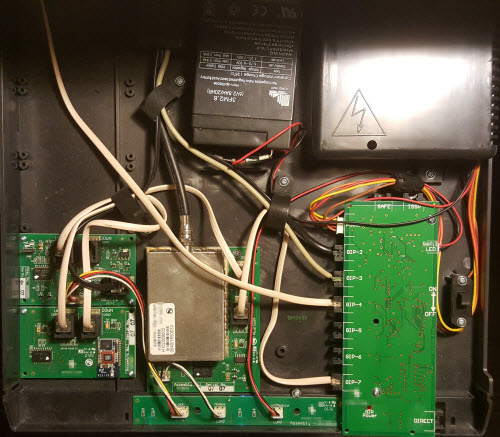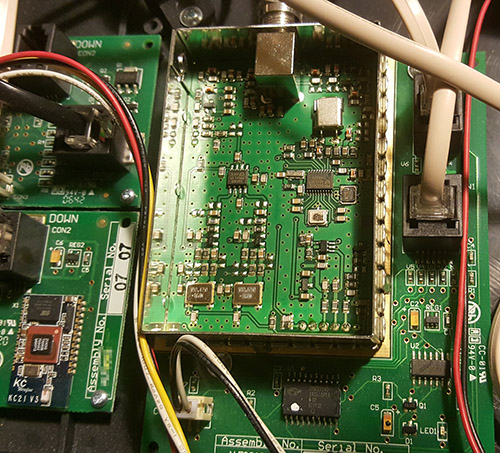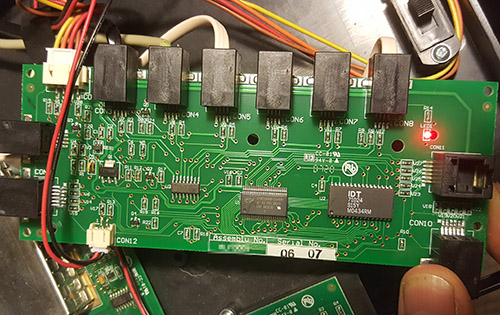The Ware for October 2017 is shown below.



Sometimes a ware just presents itself to you among your travels; thankfully cell phone cameras have come a long way.
This entry was posted on Thursday, October 26th, 2017 at 2:40 am and is filed under name that ware. You can follow any responses to this entry through the RSS 2.0 feed.
Both comments and pings are currently closed.
There’s not a lot of logic here, so whatever it is is probably fairly dumb. I’m seeing a battery, a bunch of 4P4C connectors, and a modem with a co-ax cable coming out of it.
…Some sort of multi-line VoIP box?
With the seven GIP sockets feeding into a 74HC-series chip that I can’t quite make out the part number on, my initial guess would be an alarm system with a cable internet uplink.
Some kind of RF modem in the metal shielding, probably with an antenna cable. SA630 is an RF SPDT switch; SA636 an IF mixer. The RF box doesn’t seem to contain a lot of additional logic; given all those vias, the other side of the PCB probably doesn’t contain any large chip. IMO that rules out any kind of high-speed / high-bandwidth communication; processing is probably done in the CY8Cxxx pSoC, which probably also implements whatever proprietary bus runs over those 4P4C connectors.
There’s a bluetooth module (KC21 v3 in lower left) and some kind of “lock” / “no lock” module, curiously jupered for neither. The 4P4C bus is obviously intended for quick in-the-field hookup of modules; the ON/OFF label printed on the PCB also suggests that some semi-skilled person is expected to open this thing and wire things up.
Given that prominent battery, I’m going to go for some kind of wireless alarm system that needs to have some form of backup power. The easy-to-wire bus thing with most (3) of the bus wires leaving the box seems to fit the bill: You wire up whatever modules you purchased inside the box, and connect your external sensors to the hub / main PCB on the lower right.
Has to be a barrier control system. IE rolling gate/garage door/chainlink gate/etc. Likely some sort of interconnected control, and the GIP ports are safety sensors. Modem port probably uses serial to connect to the control system.
From the markings on the XTALs (10.475, 10.675 and 83.275), I guess that the radio transmits and/or receives on 72.6 and 72.8 MHz. Trawling FCC brings up a fire alarm box that transmits in that range (FCC-ID AGJ-KFSTARLB0001), so the guesses up-thread could be on the right track.
garage door (or gate, etc.) opener or alarm system
It’s not a typical commercial garage door opener. And the custom stuff tends to be build by control panel houses and looks more DIN-rail-and-PLC-ish. It *might* be a gate opener; that industry is fragmented and there are some niche players that might have that kind of relatively high-margin, custom-configured stuff.
I’d guess an elevator control or maybe an industrial safety door/barrier operator (like you’d have on a larger industrial machine).
The wireless module on the bottom up/down control/sensor interface with the chip antenna is interesting.
Typically gate and door openers will integrate the motor control with the kind of high-level state monitoring implied in this box. Also the jargon in the barrier operator industry is “open” and “closed” not “up” and “down”. An elevator control or monitor would have more states, one for each station. No tell-tales of the security industry either, except for the battery backup, which would usually be a 5AH SLA.
It’s telling that the “motherboard” with all the I/O on the right has posts for the “on/off” switch molded into the box which would indicate the base unit is produced in some quantity.
I’d guess at this point a building monitoring system for something like loading dock levelers or other lift controls.
I think the up/down is referring to direction of chaining of modules on a serial bus. A cable goes from GIP-7 on the main board to the VHF modem, entering UP (not visible). Exiting on the DOWN port it then goes to the board with the Bluetooth module, again entering UP. Finally exiting DOWN it enters UP on the module on the center left. So UP is the direction of the main board.
I take “Up” to be the uplink, and “Down” to be the downlink. Which makes the device a concentrator.
Elevator manufacturers have something with safety. This construction definitely has not.
Door panel with wireless controls & open / switch alarms.
With the Pb crossed out it is also a ROHS product. Seems to be a very old fashioned construction type for something fairly recent.
This reminds me of the old CCTV camera system by Philips (and possibly others). They used phone cable for connections, and had a box for interfacing to a regular monitor. I still have some of their old components in storage somewhere, but no time to confirm the theory. It was all analog with some digital control thrown in, just as in the pictures here.
I think this is some sort of vending machine controller. The one image has 3 plugs… Lock, Modem and what looks like Coin Module
My guess is some sort of weather station.
Coin operated entry system, e.g. for public restrooms. Bluetooth and VHF modems may be for reporting/maintenance, or coin-less access.
Some sort of fire alarm ? The big RF module in the center would be used to receive information from remote trigger that can’t be wired directly. That would explain the fat ass battery, however I don’t know why there’s a bluetooth module. For configuration purposes, maybe ?
Adrian figured it out before me :(
it is some sort of satellite / marine / aircraft phone exchange with data capability
last guess — remote voip gateway, PBX
Among your travels? Could this be a unit you found in a train? Maybe some sort of hardware-configurable gateway to provide internet access to travellers?
1) It’s not a fire panel/alarm, if only because this shoddy setup is unacceptable for life safety applications. It’s an access control panel.
2) There’s no “coin module”. The obscured word is “main module”, and the cable going from CON3 on bottom PCB goes to the “GIP POWER” pcb, to its “[word obscured] LED” / CON12 connector, not to some coin module.
3) the serial link looks like some rs485 system, daisy chained
Nice response in return of this difficulty with genuine arguments and
describing everything about that.